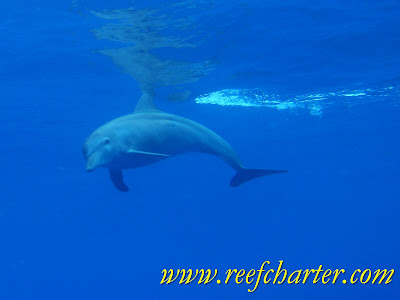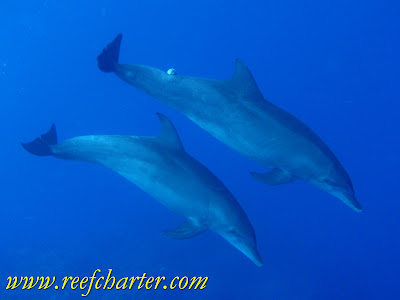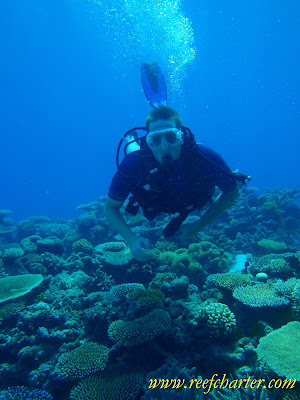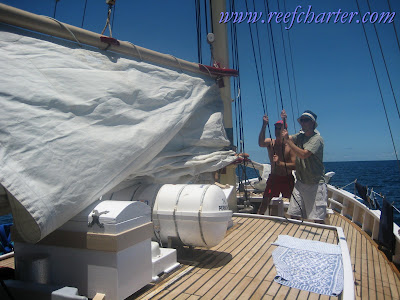Mother nature often gives us some amazing experiences, here two dolphins decided they would like to come and do some diving with us. These two friendly dolphins followed and interacted with our divers and snorkelers for quite a long time. Enjoying the interaction and playing along side our guests and tagging along with our divers. An encounter with a dolphin like this is a fantastic experience and will leave memories that last a lifetime.
Remember, we do not feed or do other activities to attract marine life, so this interaction is completely natural. Making the encounter even more special and truly appreciated. The Great Barrier Reef truly is a natural wonder of diverse and wonderful experiences to be had everyday. If you haven’t been yet you owe it to yourself and family come and experience it. It truly is one of the great wonders of the world and has to be seen to be believed. Yes I love this place! :)
For more photos check out our Tour Photos page or to come and experience the fantastic Great Barrier Reef have a look at our website.
Tag: Scuba Diving
10 Tips for Seeing the Most While You Scuba Dive
Seeing many scuba divers from all around the world we get to educate our guests on the best way to experience the wonders of the Great Barrier Reef. So to help everyone out wherever you are we put together these tips to help you see more and experience a more interactive diving experience. The best way to see any dive site is with a guide who knows the area and the native wildlife or coral formations in the area. Don’t be afraid to ask them about the site or tell them what you are interested in.
1. Relax and take things slowly when you dive. Remember you are a stranger with lots of bubbles in the underwater world, so by relaxing and not appearing as a threat you will get more fish remaining for you to enjoy.
2. You are in the homes of the fish, turtles and other marine life that you are looking at. Respect that as you would a friends house. Do not disturb the natural surroundings, avoid kicking up sand and definitely not the coral. So practice your buoyancy away from the reef. Give the fish and reef some distance between you and them about 3ft or 1metre.
3. Do not poke, prod or harass the fish. This can be dangerous to their health and sometimes yours. They will also swim away and maybe relocate so other divers will not get to see them later.
4. Always allow the marine life a clear exit path. Make sure you and your dive buddy or group stay to one side and do not surround the animal you are looking at. If the fish or turtle doesn’t feel threatened it will remain for longer and allow you a better experience.
5. Do not feed the fish, apart from it being bad for the natural ecosystem, you do not get to see the natural behaviour of fish if they are being attracted to divers for the food.
6. Move along slowly in the water and pay close attention to the seascape around you. This helps your navigation but more importantly gives you time to really pay attention to the smaller creatures such as beautiful nudibranchs. Initially frightened fish may pop back out or come back to take a closer look at you.
7. Get into routines for checking your gauges. The best equipment designers in the world not make gauge better looking then the reef that surrounds you, so spending time fiddling with your gauges unnecessarily is time wasted. You can play with your dive computer on the boat as much as you want.
8. Spend some time before you get in the water and on the surface to double check you are comfortable with your equipment. Spending time “playing” with your dive gear underwater distracts you form the dive and also makes you consume air more rapidly.
9. Don’t be afraid to stop in a spot to look more closely and examine the coral formations for starfish, crabs and other beauties that make their homes under the coral. Again relax and practice your buoyancy.
10. Stick with your buddy and take the time to point out the cool things you have found. Four eyes are better then two. Agree with your buddy before you dive on some certain types of marine life that you are interested in. By looking at the same type of marine life you both will focus on areas likely to have the creatures.
Most of all have fun, don’t be nervous and we hope to see you diving on the Great Barrier Reef shortly.
Small Fun Groups and Unique Reef Experiences
Sailing the Santa Maria around the Great Barrier Reef is one of the privileges that we get to enjoy everyday.
Experiencing the romance and character of the historic wooden yachts is a rare experience and something our guests cherish for years, many becoming ‘addicted’ and returning many times for their fix. You can’t help as you sit with only a small group of people and share the water with a select few this is how nature was meant to be experienced.
Whether you want to experience snorkelling without the masses on the water or dive and explore the reef on your own terms and schedule, visiting the reef with small groups allows you to get a more personal and relaxed experience on the reef. Time spent with other passengers and our staff get you to enjoy and learn about the reef in a more intimate and one on one setting. It is an amazing difference as you dive, snorkel and relax on the outer Great Barrier Reef enjoying the coral and wildlife in a much more serene setting.
10 Tips for Great Underwater Photos
“You Taking a Photo of Me?”
At a request from Rob here is an article on how to take some great photos in the water. Thanks for the suggestion Rob and hope to see you back in Australia shortly. If you have a request for an article on one of our specialties please ping us on Twitter.
1 . As with anything in the water it is best to best to be calm and relaxed and move slowly. Taking photos while in the water either diving or snorkeling takes a little practice and is better if you work with the elements rather then against them.
2. Try to time the taking of the photos with the movement of the water, wind and other environmental variables. Again do not fight them but relax move in harmony with the elements.
3.Whether snorkeling or diving work on your stability in the water that means your buoyancy and how you are able to balance and relax in the water. It will take some practice to be able to become stationary, but well worth the effort.
4. Start taking pictures of fixed objects first such as reefs, underwater structures, corals, etc first. This will help your stability above and give you confidence to be able to frame your picture later. Keep your distance steady, slowly adjust the camera. Making adjustments quickly and constantly will make for erractive and out of focus pictures.
5. Hire a digital camera, this way you can take as many pictures as you want without running out of film. It is best to hire a small compact digital camera without strobes until you get your buoyancy correct. Heavier cameras make it difficult to hold a steady shot for the beginner.
6. Let your dive instructor or guide know that you want to practice taking photos; this will allow them to pick something that will photograph well and also plan the dive appropriately so you have all the time you need to get confident.
7. Ask questions of your tour staff, they will be more then happy to show pointers and evaluate how to improve your photos if you ask.
8. Avoid crowds, dodging other divers and snorkelers will frustrate you as well as take away your focus from your job at hand. Stay with a friend and pay attention to each other to make sure you are in contact, it is very easy to get separated while taking photos.
9. Have fun and try to photograph subject matter you are interested in, this will make the process a lot more enjoyable and you’ll be surprised how quickly you improve if there is a little passion behind your photos.
10. Once you are confident and taking some good photos of corals have a go at the fish or turtles. If the fish or moving animals move away from you do not chase them. No matter how good a swimmer you think you are they are better. Relax and move on to the next object, if you are calm and relaxed they may even circle back giving you another opportunity for that perfect photo.
As you can see to start taking good photos you have to be relaxed and most of all enjoy the experience. After a short time you’ll be taking some great photos that you’ll be proud to show your friends, colleagues and relatives for years to come. Here are some of the photos that our previous guests have taken. You too can be taking some great photos on the reef in a short time also. So if you are heading to Cairns or the Great Barrier Reef we’d love to show you some of the tricks of the trade.





